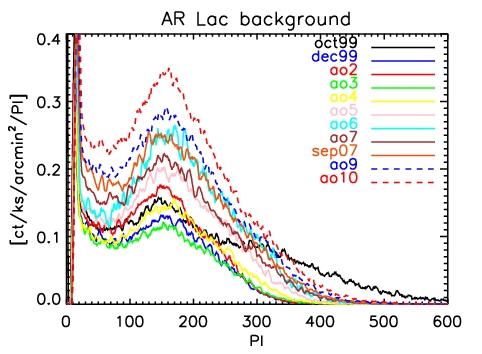


|

|
May 2010
This page describes a new calibration product: HRC-I background PI spectra, located in the CALDB at
/data/CALDB/data/chandra/hrc/bgspec/hrciDYYYY-MM-DDpibgspecN0001.fits .
There is one background PI spectrum per year. The spectra can be used to calculate a custom PI filter to reduce background, as explained in the HRC-I Background Spectra CIAO thread. The files were first introduced in CALDB 4.3.
For each year, we extract events in a 800x800 pixel box at the 17 observation locations < 10 arcminutes from the aimpoint, excluding the location where the source is located. We sum the PI spectra from each location, weighing by exposure time, to create the final PI spectrum for the year. Finally, the PI spectra are Loess-smoothed with a third degree polynomial fit over ranges 10 channels wide.
The following figure shows the PI spectra for each year.

Here, we compare spectra extracted from the stowed event lists to the background spectra derived from the AR Lac observations. First, we compare total counts in the background AR Lac spectra to total counts extracted in the same regions from the stowed event lists, after normalizing by the appropriate exposure time. We find that the counts can differ by +/- 20%.
| Year | 2000 | 2001 | 2002 | 2003 | 2004 | 2005 | 2006 | 2007 | 2008 | 2009 | |
|---|---|---|---|---|---|---|---|---|---|---|---|
| Stowed/AR Lac | 0.79 | 0.88 | 1.19 | 1.03 | 0.99 | 0.81 | 1.07 | 1.21 | 1.12 | 1.12 |
Next, we compare the shape of the AR Lac and stowed background spectra after normalizing each to total counts. We find that the shapes are similar, with reduced chi-square values for PI=40:300 ranging from 0.99-1.72. Over a PI=1:400, the reduced chi-square values are a bit larger.
| Year | 2000 | 2001 | 2002 | 2003 | 2004 | 2005 | 2006 | 2007 | 2008 | 2009 | |
|---|---|---|---|---|---|---|---|---|---|---|---|
| red. chi-sq 40:300 | 1.72 | 1.20 | 1.20 | 1.41 | 1.37 | 1.41 | 0.99 | 1.16 | 1.08 | 1.07 | |
| red. chi-sq 1:400 | 2.11 | 1.67 | 1.45 | 1.84 | 1.85 | 1.48 | 1.63 | 1.50 | 1.37 | 1.31 |
We suspect that the differences in intensity and spectral shape between the AR Lac and stowed backgrounds are because the stowed event lists are summed over an entire year, while the AR Lac backgrounds sample only a few consecutive days of each year.
Last modified: 09/27/12
 |
The Chandra X-Ray
Center (CXC) is operated for NASA by the Smithsonian Astrophysical Observatory. 60 Garden Street, Cambridge, MA 02138 USA. Email: cxcweb@head.cfa.harvard.edu Smithsonian Institution, Copyright © 1998-2004. All rights reserved. |